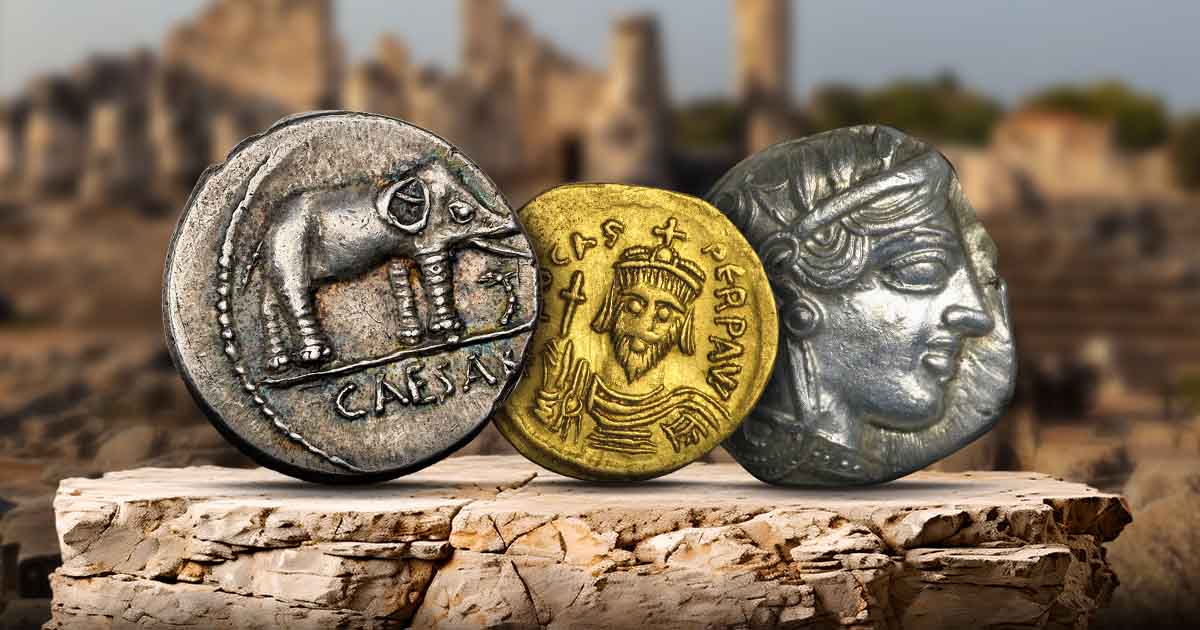
Ancient coins were produced by ancient civilizations mostly by manual labor. The first known ancient coins appear to have been created in what is now modern-day Türkiye in around 600 BCE. Ancient Greek, Roman, Persian, and Chinese civilizations produced coins.
The adoption of the usage of coins for trade and bartering greatly influenced the modern world and our monetary systems. Even today we still track how much money can be “traded” for common goods.
Modern coins on the other hand were created using mechanical minting techniques.
Examples of Ancient Coins
Greek Coins
Athenidan Owl Tetradracham
This coin features Athena and the Athenian Owl. This design was used for hundreds of years. It was minted in Ancient Greece, but they traveled all over the ancient world.
Alexander the Great Tetradacham
This coin was circulated during Alexander’s reign and they feature Hercules and Zeus.
Roman Coins
Denarius
Ancient Rome began producing coins around 200 BCE and they used the silver Denarius coin for five hundred years. It features the goddess Roma. Romans created this silver coin to conduct commerce with Greece.
Aureus
Unlike the Denarius, the Aureus is a gold coin. It was worth roughly 25 Denarius and was used for larger transactions. Like many civilizations, though the years the coins had decreaed levels of gold content.
Persian Coins
Daric
These coins featured King Darius 1. They are gold coins but are quite rare as many were melted down and restruck.
Chinese Coins
Ban Liang
This was one of the first coins utlized in the Chinese Empire. This was a bronze currency and are round with a square hole in the middle.
Why Collect Ancient Coins
Coin collectors collect ancient coins for personal and investment purposes. Regardless of the purpose, most find better success in finding and collecting ancient coins if they have a passion for it.
Reasons collectors collect ancient coins,
Historic Interest
Researching and collecting ancient coins is fascinating. Each piece tells a story about human history. Many collect ancient coins because they have an interest in a specific time or era in history.
Educational Value
Some collect ancient coins to educate themselves and others. Some can better imagine a historical time if they can see artifacts from that time. Coins may be kept in museums or educational institutions to educate the curious.
Rarity
In some cases, only a handful of coins still exist. Many enjoy looking for and collecting sought-after coins. Rare coins can be incredibly valuable and are of high interest to those interested in coinage and history.
Investment Potential
Some collect rare ancient coins for the chance to resell for a profit. Or they may choose to hold coins as a store of value or as part of their inheritable estate.
Conservation
If ancient coins are removed from general circulation they are more likely to be preserved if they are held by a person or entity who can care for them. These type of conservationist may hold them in a trust or leave them to an interested museum or other type of preservation entity when they pass.
Ancient coins directly link to the past, capturing key historical moments, and they provide educational insights into ancient civilizations. The limited supply and unique historical context of many ancient coins make them highly sought after and valuable.
For collectors, these coins offer an insightful view into the past, showcasing the artistry and history of ancient civilizations. For investors, ancient coins provide a unique and tangible asset that can diversify a portfolio and potentially appreciate.




